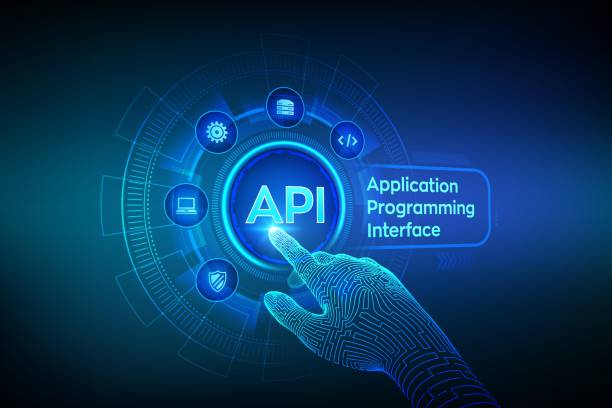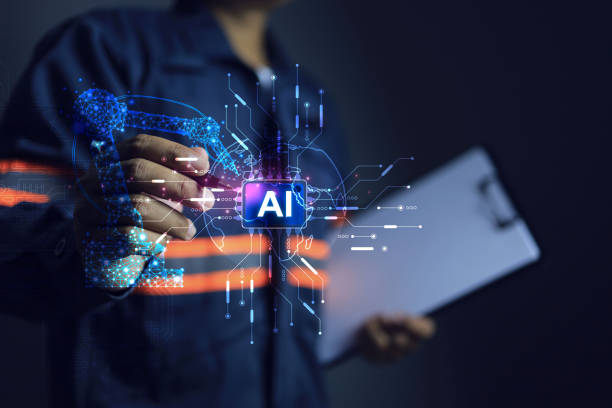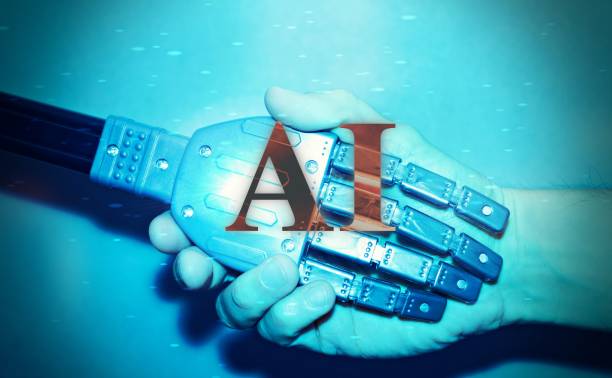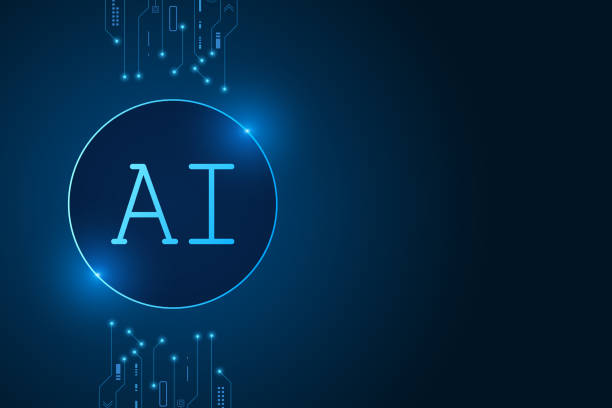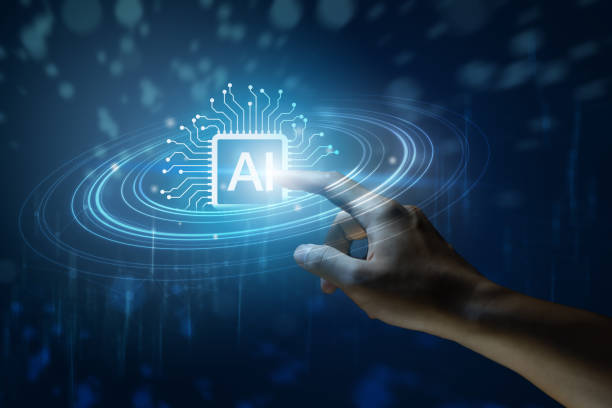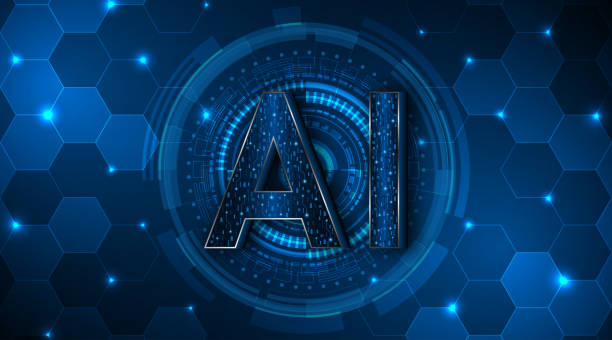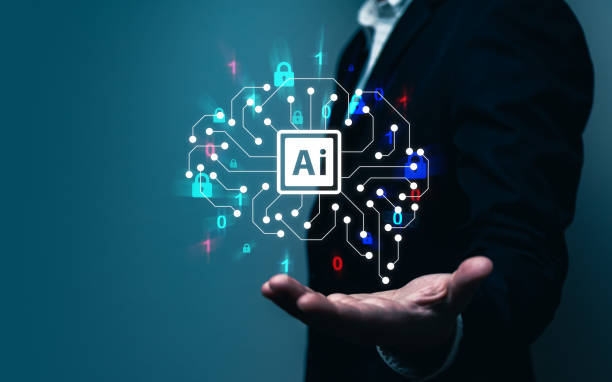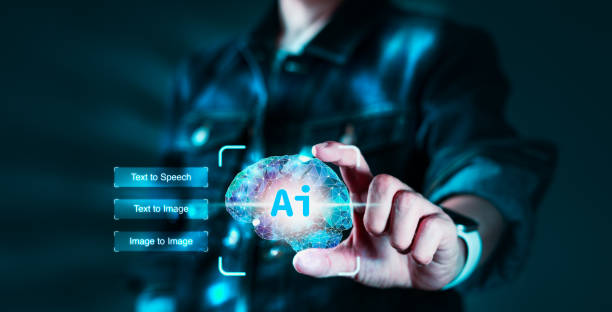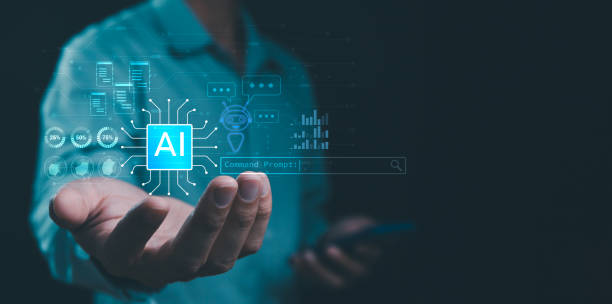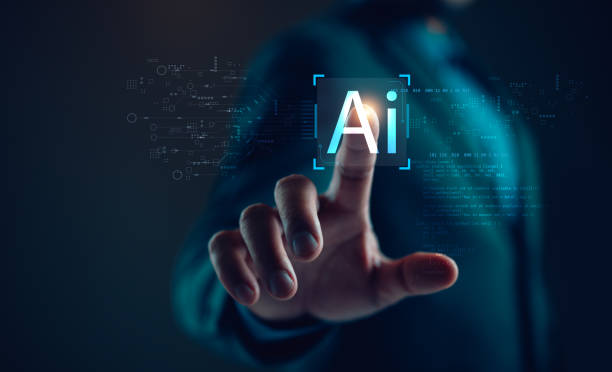What is an Artificial Intelligence Robot and How Does it Work?
Artificial Intelligence Robot is a combination of two important technology fields, namely #Artificial_Intelligence and #Robotics.
Simply put, these robots are physical or software devices that use artificial intelligence algorithms to perform tasks that typically require human intelligence.
These tasks can include learning, reasoning, problem-solving, natural language understanding, and pattern recognition.
Artificial intelligence enables robots to interact with their surroundings and make decisions based on the data they receive.
For example, an artificial intelligence robot can be responsible for inspecting the quality of products in a factory, or assist nurses in caring for patients in a hospital.
How artificial intelligence robots work depends on the type of task they are designed for, but in general, these robots use sensors to collect information from their surroundings.
This information is then analyzed by processors and artificial intelligence algorithms make decisions based on this information.
These decisions can include movement, manipulation of objects, answering questions, or performing other tasks.
Robotics plays an important role in the physical structure of these robots, but it is artificial intelligence that gives them the ability to learn and adapt to different conditions.
Artificial intelligence robots are currently used in various industries such as manufacturing, healthcare, customer service, and logistics, and their role is expected to become increasingly important in the future.
One of the key applications of artificial intelligence robots is the automation of repetitive and dangerous tasks.
By using robots equipped with artificial intelligence, companies can increase their productivity and reduce their costs, while also improving the safety of their employees.
Artificial intelligence robots can also help people with disabilities perform daily tasks and improve their quality of life.
Is your current online store design causing you to lose customers and sales?
Rasaweb is your solution with modern and user-friendly online store designs!
✅ Significant increase in conversion rates and sales
✅ Creating strong branding and gaining customer trust
⚡ Get a free online store design consultation from Rasaweb!
Types of Artificial Intelligence Robots: Introduction and Review
Artificial intelligence robots can be categorized based on various criteria.
One of the most common methods is to categorize them based on the type of application and task that the robot performs.
Accordingly, artificial intelligence robots can be divided into the following categories:
- Industrial robots: These robots are used in factories and production lines to perform tasks such as welding, painting, packaging, and assembling parts.
- Service robots: These robots are used in service environments such as hospitals, hotels, restaurants, and stores to perform tasks such as cleaning, delivering food, answering customer questions, and providing healthcare services.
- Medical robots: These robots are used in hospitals and medical centers to perform surgical procedures, rehabilitate patients, and assist nurses in caring for patients.
- Military robots: These robots are used in military fields to perform tasks such as reconnaissance, bomb disposal, border patrol, and intelligence gathering.
- Educational robots: These robots are used in schools and universities to teach scientific and technical concepts to students.
- Home robots: These robots are used in homes to perform tasks such as cleaning, caring for children and the elderly, and providing entertainment.
Click here to preview your posts with PRO themes ››
In addition, artificial intelligence robots can also be categorized based on the type of artificial intelligence used.
For example, robots that use machine learning can identify patterns by analyzing data and make decisions based on these patterns.
Robots that use natural language processing can understand and respond to human language.
And robots that use computer vision can process images and videos and recognize objects and people in them.
Amazing Applications of Artificial Intelligence Robots in Various Industries
Artificial intelligence robots are creating huge transformations in various industries.
In the #Manufacturing sector, these robots can perform repetitive and dangerous tasks, improve product quality, and reduce costs.
For example, in the automotive industry, artificial intelligence robots can weld and paint car parts with high precision and speed.
In the #Healthcare sector, artificial intelligence robots can assist surgeons in performing complex operations, discover new drugs, and help patients in rehabilitation.
Robots based on artificial intelligence also play an important role in the #Customer_Service sector, for example, chatbot robots can answer customer questions and solve their problems.
In the #Logistics sector, artificial intelligence robots can determine optimal routes for transporting goods, manage warehouses, and assist drivers in driving.
In the #Agriculture sector, artificial intelligence robots can inspect fields, identify pests, and assist farmers in harvesting crops.
Also, artificial intelligence robots are being used in the #Education sector, for example, educational robots can help students learn new concepts and help teachers in teaching.
In the future, it is expected that the applications of artificial intelligence robots will expand and these robots will play a role in all aspects of our lives.
However, it is necessary to pay attention to the ethical and social challenges associated with the use of artificial intelligence robots and to develop laws to regulate the use of this technology.
| Industry | Application of Artificial Intelligence Robot |
|---|---|
| Manufacturing | Welding, Painting, Assembly |
| Healthcare | Surgery, Rehabilitation, Drug Discovery |
| Customer Service | Answering Questions, Solving Problems |
| Logistics | Route Optimization, Warehouse Management |
| Agriculture | Field Inspection, Pest Identification |
Advantages and Disadvantages of Using Artificial Intelligence Robots
Using artificial intelligence robots has many advantages.
These robots can perform repetitive and dangerous tasks with high accuracy and speed, increase productivity, reduce costs, and improve the quality of products and services.
Also, artificial intelligence robots can help people with disabilities perform daily tasks and improve their quality of life.
However, using artificial intelligence robots also has disadvantages.
One of the most important disadvantages is job loss.
With the automation of tasks, many people lose their jobs, and this can lead to economic and social problems.
In addition, the use of artificial intelligence robots can lead to over-reliance on technology, and this can increase our vulnerability to cyber-attacks and power outages.
Also, the use of artificial intelligence robots can lead to ethical concerns.
For example, if an artificial intelligence robot makes a decision that harms a human, who will be responsible? It is necessary to pay attention to these challenges and develop laws to regulate the use of artificial intelligence robots so that we can benefit from the advantages of this technology and avoid its disadvantages.
Does your current company website not reflect the credibility and power of your brand as it should? Rasaweb solves this challenge for you with professional company website design.
✅ Increase the credibility and trust of visitors
✅ Attract more targeted customers
⚡ Click to get a free consultation!
What Does the Future Hold for Artificial Intelligence Robots?
The future of artificial intelligence robots is very bright and promising.
It is expected that in the future, these robots will play a role in all aspects of our lives and make our lives easier and better.
As technology advances, artificial intelligence robots will be able to perform more complex tasks and interact with humans more naturally.
For example, in the future, we may have robots that can empathize with humans and help them solve emotional problems.
Also, we may have robots that can help us learn new skills and help us achieve our goals.
However, it is necessary to pay attention to the challenges associated with the advancement of artificial intelligence robots.
One of the most important challenges is protecting privacy.
With the collection and analysis of personal data by artificial intelligence robots, our privacy is at risk, and it is necessary to develop laws to protect people’s privacy against these threats.
Also, it is necessary to pay attention to the development of artificial intelligence robots in such a way that they are accessible to everyone and prevent discrimination.
How to Choose an Artificial Intelligence Robot for Your Business
Choosing the right artificial intelligence robot for your business is an important decision that can have a significant impact on your success.
To choose the right robot, you must first carefully evaluate your business needs.
What tasks do you want to delegate to the robot? What problems do you want to solve using the robot? After determining your needs, you should look for robots that are capable of performing these tasks and solving these problems.
When choosing a robot, pay attention to various factors such as price, performance, reliability, ease of use, and technical support.
Also, you should make sure that the robot is compatible with your existing systems and can be easily integrated with them.
Before buying a robot, be sure to test it and make sure that its performance meets your expectations.
Also, request suitable technical support services from the robot vendor so that you can easily solve any problems that arise.
One of the important criteria in evaluating an artificial intelligence robot is its ability to learn and adapt to new conditions.
A robot that can continuously learn and improve its performance can create more value for your business in the long run.
Therefore, when choosing a robot, look for robots that use advanced machine learning algorithms and are able to learn from their data and experiences.
Ethical Challenges of Using Artificial Intelligence Robots
Using artificial intelligence robots creates numerous ethical challenges.
One of the most important challenges is accountability.
If an artificial intelligence robot makes a decision that harms a human, who will be responsible? Will the robot’s manufacturer, the robot’s owner, or the robot itself be responsible? These questions do not have simple answers and need to be carefully considered.
Another challenge is discrimination.
If an artificial intelligence robot is trained on discriminatory data, it may make decisions that are discriminatory.
For example, if a hiring robot is trained on data that shows that men are more suitable for a particular job than women, it may ignore women in the hiring process.
To prevent this from happening, it is necessary to carefully select the training data for robots and prevent any discrimination in them.
Another challenge is privacy.
Artificial intelligence robots need to collect and analyze people’s personal data to perform their tasks.
This data can include sensitive information such as medical records, financial information, and information about people’s online activities.
To protect people’s privacy, it is necessary to develop laws to regulate how this data is collected, stored, and used.
| Ethical Challenge | Description |
|---|---|
| Accountability | Determining responsibility in the event of a robot’s wrong decision |
| Discrimination | Potential for discriminatory decision-making based on training data |
| Privacy | Protection of personal data collected by the robot |
Artificial Intelligence Robot Security: How to Protect Our Robots
The security of artificial intelligence robots is a very important issue that needs to be addressed.
Artificial intelligence robots can be the target of cyber attacks, and if hacked, they can cause a lot of damage.
For example, a hacker can hack an industrial robot and force it to produce defective products.
Or a hacker can hack a medical robot and force it to provide incorrect treatments.
To protect your artificial intelligence robots from cyber attacks, you must take appropriate security measures.
One of the most important measures is to use strong and unique passwords for all devices and systems related to the robot.
Also, you should install appropriate security software on the robot and update it regularly.
In addition, you should properly configure your network and use firewalls and intrusion detection systems.
You should also train your employees on how to protect robots from cyber attacks.
In general, the security of artificial intelligence robots is an ongoing process that requires constant attention and effort.
By taking appropriate security measures, you can reduce the risk of cyber attacks and protect your robots from damage.
Also, as technology advances, it is necessary to constantly update your security methods and be aware of the latest cyber threats.
Are you falling behind in competition with large online stores?
Rasaweb will bring your business online with a professional online store design and increase your market share!
✅ Increase brand credibility and customer trust
✅ Easy shopping experience leads to more sales
⚡ Act now to get a free website design consultation!
The Impact of Artificial Intelligence Robots on the Labor Market
The impact of artificial intelligence robots on the labor market is a matter of debate.
Some experts believe that these robots cause job losses, while others believe that these robots create new jobs.
The reality is that the impact of artificial intelligence robots on the labor market is complex and depends on various factors.
In general, artificial intelligence robots can automate repetitive and dangerous tasks, and this can lead to the loss of jobs that perform these tasks.
However, artificial intelligence robots can also create new jobs.
For example, there is a need for new specialists to design, build, maintain, and repair robots.
In addition, artificial intelligence robots can increase productivity, and this can lead to economic growth and the creation of new jobs in other sectors.
In order to benefit from the advantages of artificial intelligence robots and avoid their disadvantages, it is necessary to adopt appropriate policies.
One of the most important policies is investing in education.
We must educate people on how to work with artificial intelligence robots and how to learn new skills that are needed in the future labor market.
Also, it is necessary to support people who lose their jobs and help them find new jobs.
In general, the impact of artificial intelligence robots on the labor market is inevitable, and we must be prepared for these changes.
Is the Artificial Intelligence Robot a Threat to Humans?
The question of whether the artificial intelligence robot is a threat to humans is a complex question that does not have a definitive answer.
Some people worry that artificial intelligence robots will eventually get out of human control and become a threat to humanity.
For example, Stephen Hawking, the famous physicist, warned that artificial intelligence could be the end of human civilization.
However, many experts believe that these concerns are exaggerated.
They believe that humans can design and program artificial intelligence robots in a way that they are safe and useful.
They also believe that humans can develop laws to regulate the use of artificial intelligence robots and prevent abuse of this technology.
Ultimately, whether artificial intelligence robots are a threat to humans depends on our decisions and actions.
If we use this technology carefully and responsibly, we can benefit from its advantages and avoid its disadvantages.
But if we are negligent and do not pay attention to the ethical and security challenges associated with artificial intelligence robots, we may face serious risks.
It should also be remembered that artificial intelligence is just a tool that is made and used by humans, and the responsibility for how it is used rests with us.
Frequently Asked Questions
| Question | Answer |
|---|---|
| What is an Artificial Intelligence Robot? | An Artificial Intelligence Robot (AI Robot) is a machine capable of understanding the environment, reasoning, learning, and making decisions to perform tasks independently. |
| What is the difference between regular robots and artificial intelligence robots? | Regular robots perform repetitive tasks based on pre-programming, while artificial intelligence robots can learn from experience, interact dynamically with the environment, and even behave in a way that resembles human intelligence. |
| What are the main applications of artificial intelligence robots? | They are used in industries (manufacturing, assembly), medicine (surgery, diagnosis), services (customer support, domestic), exploration (space, underwater), and many other fields. |
| What technologies are used in the construction of artificial intelligence robots? | Machine Learning, Computer Vision, Natural Language Processing, Deep Learning, and Robotics are among the key technologies. |
| Can artificial intelligence robots have emotions? | Currently, robots do not have emotions in the human sense. They can identify and react to emotions, but they do not experience emotions themselves. |
| What are the main challenges in developing artificial intelligence robots? | Safety, reliability, ethics, autonomy, compatibility with complex environments, and natural interaction with humans are important challenges. |
| How are artificial intelligence robots trained? | They are usually trained using a large amount of data, machine learning algorithms, and deep learning to identify patterns and make decisions. |
| Examples of artificial intelligence robots in everyday life? | Smart robotic vacuum cleaners, customer support chat robots, self-driving cars, and surgical robots in hospitals. |
| Are artificial intelligence robots a threat to human jobs? | Some repetitive jobs may be automated, but at the same time, robots can increase productivity and create new jobs in the development, maintenance, and monitoring of these systems. |
| How is the future of artificial intelligence robots predicted? | They are expected to become smarter, more autonomous, and capable of performing more complex tasks, and will interact more closely with humans in various environments. |
And other services of Rasa Web advertising agency in the field of advertising
Smart direct marketing: A creative platform to improve digital branding by customizing the user experience.
Smart Google Ads: A new service to increase customer attraction through the use of real data.
Smart Sales Automation: Transform SEO ranking by designing an attractive user interface.
Smart Google Ads: Designed for businesses looking to increase click-through rates by optimizing key pages.
Smart Social Media: A new service to increase digital branding through intelligent data analysis.
And more than hundreds of other services in the field of internet advertising, advertising consulting and organizational solutions
Internet Advertising | Advertising Strategy | Reportage Advertisement
Resources
Intelligent Robots in 2023
,Types of Robots and their Applications
,Types of Robots: From Industrial to Artificial Intelligence
,What is a Smart Robot?
? Are you looking for a big leap in the digital world? Rasa Web Digital Marketing Agency, with expertise in SEO, Google advertising, and modern user interface website design, is a comprehensive solution for the growth and excellence of your business in the online space.
📍 Tehran, Mirdamad Street, next to the Central Bank, Kazerun Jonoubi Alley, Ramin Alley No. 6

